New 'study' claims it takes 48k miles for electric vehicles to emit less CO2 than gasoline cars.
But it's just a misleading brochure.
Reality is closer 16k miles.
UK media including @thetimes where mislead by this carmaker-paid attack on @BorisJohnson's green plans. (thread)
But it's just a misleading brochure.
Reality is closer 16k miles.
UK media including @thetimes where mislead by this carmaker-paid attack on @BorisJohnson's green plans. (thread)

About me:
I research electric vehicles at @TUeindhoven and direct NEONresearch.nl.
Comparing CO2 emissions of electric vehicles and combustion cars is my specialty.
My paper describing common errors: sciencedirect.com/science/articl…
A recent report:
avere.org/wp-content/upl…
I research electric vehicles at @TUeindhoven and direct NEONresearch.nl.
Comparing CO2 emissions of electric vehicles and combustion cars is my specialty.
My paper describing common errors: sciencedirect.com/science/articl…
A recent report:
avere.org/wp-content/upl…
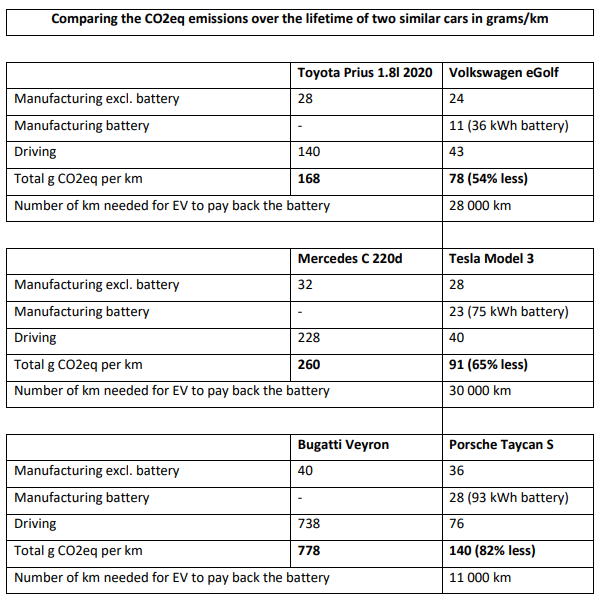
Here is @thetimes @GraemePaton reporting on 'a study commissioned by vehicle and technology companies' where 'researchers recorded results'.
thetimes.co.uk/article/electr…
And there's literally dozens of others who fell for this.


thetimes.co.uk/article/electr…
And there's literally dozens of others who fell for this.

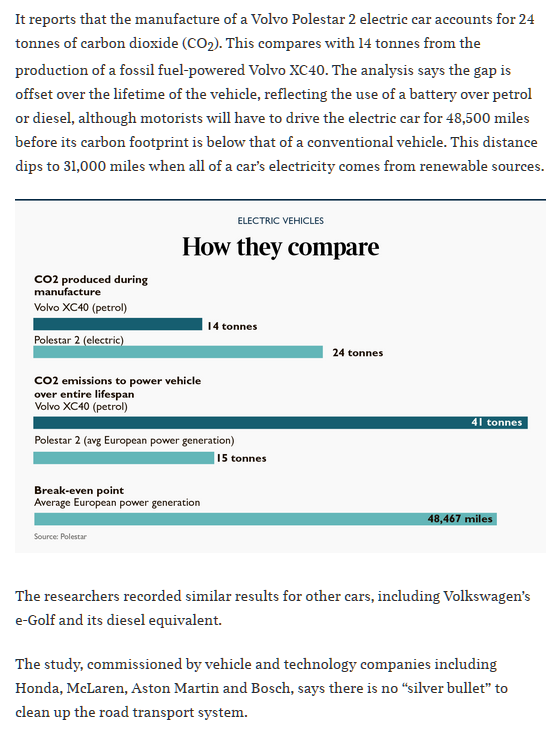
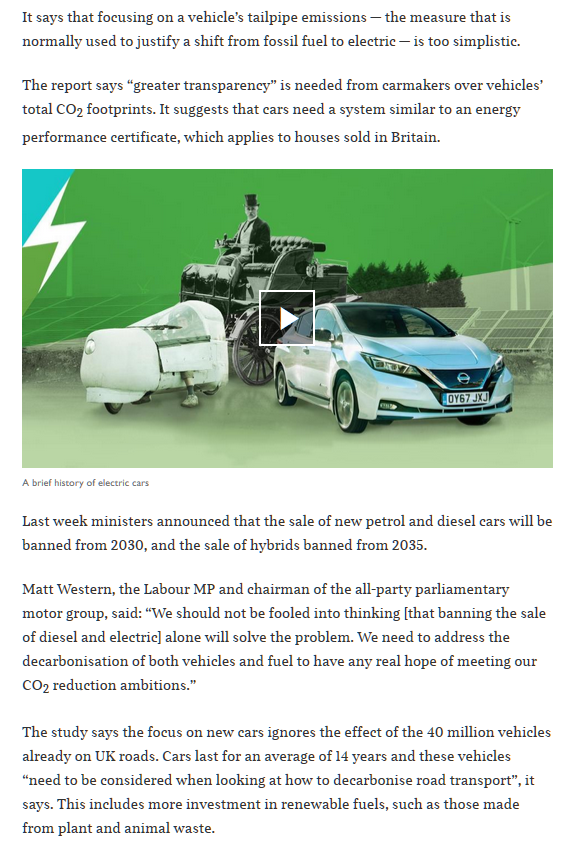
There were no 'researchers' involved in this 'study' as far as I can see and there are no original 'recorded results'.
dropbox.com/s/4lh5prkwzn49…
It looks like some lobbyists and a PR firm produced a brochure for their list of sponsors: a who's who of anti-EV organisations.
dropbox.com/s/4lh5prkwzn49…
It looks like some lobbyists and a PR firm produced a brochure for their list of sponsors: a who's who of anti-EV organisations.

The brochure goes all out to bamboozle with marketing speak but there's roughly three types of numerical misdirection:
1) Combustion engine emissions
2) Electric vehicle emissions
3) Biofuel emissions
1) Combustion engine emissions
2) Electric vehicle emissions
3) Biofuel emissions
The report underestimates combustion engine emissions ~50% by substituting reality with laboratory tests and forgetting fuel production.
First the laboratory tests. The table from the brochure looks fine but the graph over time from the source is going up. What's happening?

First the laboratory tests. The table from the brochure looks fine but the graph over time from the source is going up. What's happening?
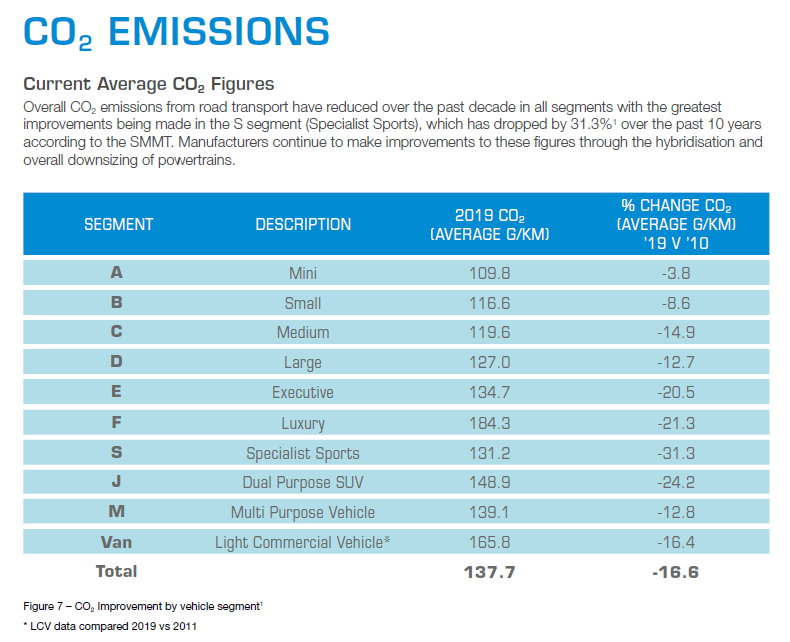
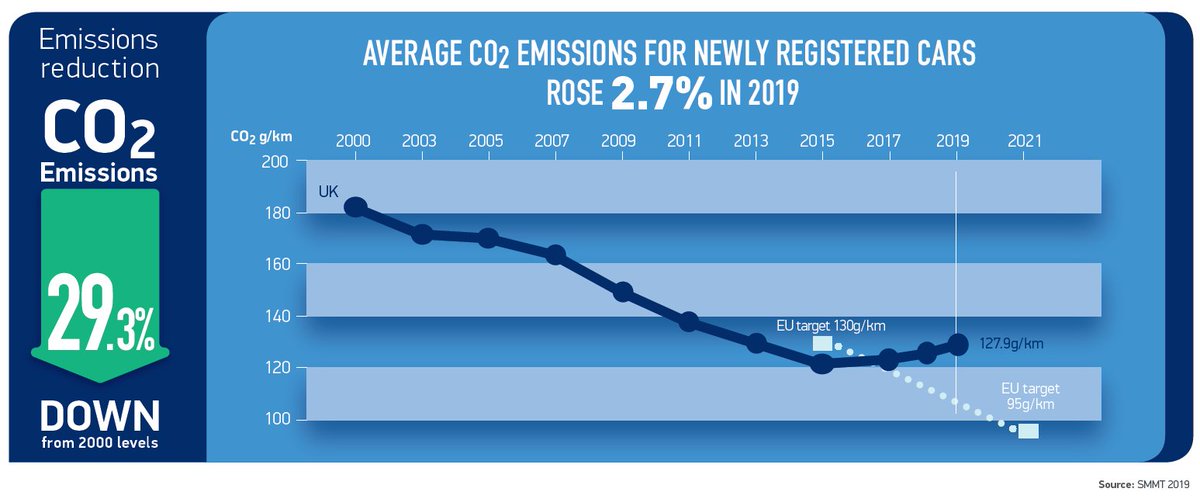
Well, the tests are going up because from 2017 on the laboratory test became more realistic.
Why? Because after #dieselgate the EU finally could not conceal anymore that the brochure that car buyers and politicians use is around 40% rosier than reality.
sciencedirect.com/science/articl…
Why? Because after #dieselgate the EU finally could not conceal anymore that the brochure that car buyers and politicians use is around 40% rosier than reality.
sciencedirect.com/science/articl…

But even the new (WLTP) test is still ~20% lower than reality.
And then you have to account for fuel production which adds ~25-30% to combustion engine emissions.
So it's not 137.7 g/km but ~138*1.2*1.25=~207 g/km.
And then you have to account for fuel production which adds ~25-30% to combustion engine emissions.
So it's not 137.7 g/km but ~138*1.2*1.25=~207 g/km.
https://twitter.com/aukehoekstra/status/1229108129301921792?lang=en
Now we can compare with electric vehicles.
The 'study' copies a study of ONE car and generalizes this to ALL electric vehicles by boldly claiming it takes 78k km (48k miles) before an electric vehicle emits less CO2.
A claim e.g @thetimes repeated.
polestar.com/dato-assets/11…

The 'study' copies a study of ONE car and generalizes this to ALL electric vehicles by boldly claiming it takes 78k km (48k miles) before an electric vehicle emits less CO2.
A claim e.g @thetimes repeated.
polestar.com/dato-assets/11…


This ONE study compares a Polestar electric vehicle with a combustion car from parent company Volvo.
But the WLTP emissions from the Volvo XC40 are estimated at 195 g/km when reality is 295 km: 45% more!
I established this using the EPA rating for the Volvo XC40.
But the WLTP emissions from the Volvo XC40 are estimated at 195 g/km when reality is 295 km: 45% more!
I established this using the EPA rating for the Volvo XC40.

Producing the battery of the electric vehicle emits 7 tonnes of CO2 (95 kg CO2/kWh battery) which is normal for a battery currently manufactured in China.
But that building the rest of the electric car emits 3 tonnes more is not normal because it's drivetrain is much lighter.
But that building the rest of the electric car emits 3 tonnes more is not normal because it's drivetrain is much lighter.
Some sleuthing by a tweep gave us the best possible explanation: although the Polestar and the XC40 use the same chassis they used the emissions of the factory in Belgium for the XC40 and China for the Polestar.
To compare like with like I take an XC40 also build in China.
To compare like with like I take an XC40 also build in China.
Finally: this is an LCA so you must calculate all emissions OVER THE LIFETIME of the vehicle. That also means taking the electricity mix over the lifetime.
(The brochure uses the same approach for biofuels.)
Average UK mix over the lifetime is ~100 g/kWh.
assets.publishing.service.gov.uk/government/upl…

(The brochure uses the same approach for biofuels.)
Average UK mix over the lifetime is ~100 g/kWh.
assets.publishing.service.gov.uk/government/upl…
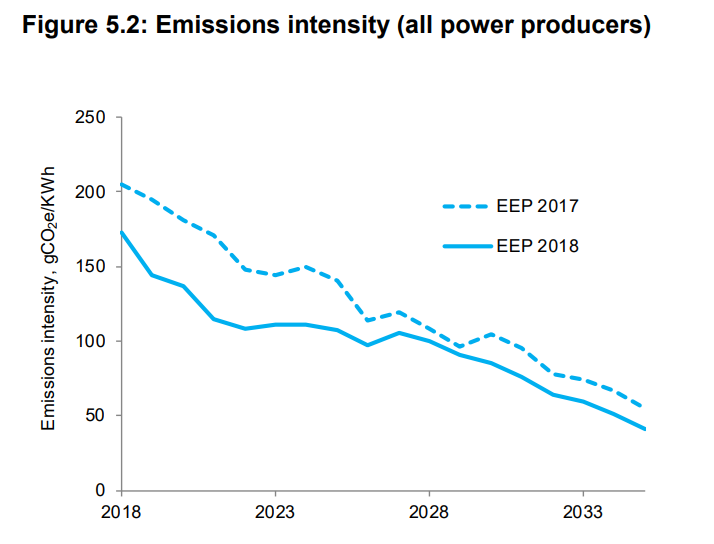

The result is this corrected graph:
1) Both cars produced in same Chinese factory: line Volvo start bit higher.
2) Realistic fuel use: line Volvo steeper.
3) UK electricity mix (cleaner than EU!) over lifetime: pretty flat line Polestar.
=> Break even from 78k km to 25k km.
1) Both cars produced in same Chinese factory: line Volvo start bit higher.
2) Realistic fuel use: line Volvo steeper.
3) UK electricity mix (cleaner than EU!) over lifetime: pretty flat line Polestar.
=> Break even from 78k km to 25k km.
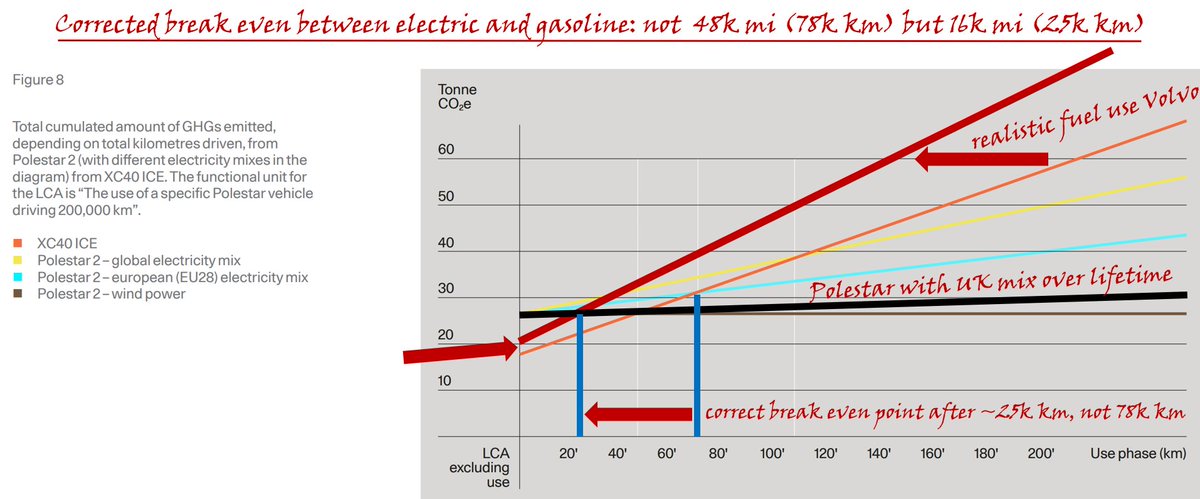
Finally some words on biofuels. The report touts them as almost emission free but their source (concawe.eu/wp-content/upl…) warns it omits land use change.
What does that mean?
It means we are again ignoring reality to protect business interests.

What does that mean?
It means we are again ignoring reality to protect business interests.


Land use change is basically simple: if I use land to produce biofuel instead of food, someone else on this world will convert a patch of nature into land for food. That negates most of my imagined reduction in carbon emissions and threatens biodiversity.
ec.europa.eu/energy/sites/e…
ec.europa.eu/energy/sites/e…
Bottom line: biofuels from waste are great but limited and should be reserved for e.g. long distance flying and sailing. Biofuels that compete with food or nature often emit more CO2 and are driving deforestation worldwide.
transportenvironment.org/what-we-do/bio…
transportenvironment.org/what-we-do/bio…
Oh and then there's the new eFuels that are now touted as a way to keep the combustion engine alive. Sorry.
eFuels require 5-6x more windmills or solar panels to produce than electric vehicles. It's a dead end for road transport. Sorry lobbyists.
transportenvironment.org/press/e-fuels-…
eFuels require 5-6x more windmills or solar panels to produce than electric vehicles. It's a dead end for road transport. Sorry lobbyists.
transportenvironment.org/press/e-fuels-…

So if you think selling combustion engines is more important than finding a job that helps us to combat climate change, that's your choice. But please stop spreading FUD.
And dear journalists: please be less gullible.
For starters I fixed the front page of the brochure.
And dear journalists: please be less gullible.
For starters I fixed the front page of the brochure.

Brilliant article in @Forbes
by @JamesMorris who reaches a larger and often anti-EV crowd than yours truly. Missing some details (e.g. energy use Volvo and Polestar uses EU mix 2019, not UK mix and not over lifetime) but hats off James!
forbes.com/sites/jamesmor…
by @JamesMorris who reaches a larger and often anti-EV crowd than yours truly. Missing some details (e.g. energy use Volvo and Polestar uses EU mix 2019, not UK mix and not over lifetime) but hats off James!
forbes.com/sites/jamesmor…
And this is a brilliant write-up of @MLiebreich on LinkedIn, detailing how his sleuthing turned boring bad numbers in a brochure disguised as a study into #AstonGate.
linkedin.com/pulse/astongat…
linkedin.com/pulse/astongat…
High quality trolling by @PolestarCars 🤣
They are just as pissed at the abuse of their life cycle analysis as I was!
Also got a lovely email (not PR BS) exchanging details so we can learn from each other. They are not the bad guys here!
They are just as pissed at the abuse of their life cycle analysis as I was!
Also got a lovely email (not PR BS) exchanging details so we can learn from each other. They are not the bad guys here!
https://twitter.com/PolestarCars/status/1333394574253973511
Seems there is some serious blow-back. Good. Why else would @ClarendonComms remove @astonmartin and @BoschGlobal as their (only) clients from their website?
Btw: this shouldn't get pinned on a few scapegoats. Esp. the newspapers should do better.
Btw: this shouldn't get pinned on a few scapegoats. Esp. the newspapers should do better.
https://twitter.com/FullyChargedDan/status/1333449750130069508?s=20
Disagree with @theLowCVP on the emissions of biofuels (that they severely underestimate imo) but glad that they distance themselves from the @astonmartin brochure regarding it's negative depiction of EVs.
Who's next?
Who's next?
https://twitter.com/aeastlake/status/1333432958951284742?s=20
This @businessinsider report gives an update of #AstonGate with reactions of the main players.
@PolestarCars rightly implies that the carbon footprint of @astonmartin and @McLarenAuto is truly abysmal when compared to an electric equivalent.
businessgreen.com/news/4024132/a…
@PolestarCars rightly implies that the carbon footprint of @astonmartin and @McLarenAuto is truly abysmal when compared to an electric equivalent.
businessgreen.com/news/4024132/a…
Here's an interview by @InnoOrigins with me about it.
I hope it's a wake-up call to UK journalists: they should not only reprint information but also check it. That's what gives them added value over social media.
Dutch: innovationorigins.com/nl/electric-au…
Englisch:innovationorigins.com/electric-auke-…
I hope it's a wake-up call to UK journalists: they should not only reprint information but also check it. That's what gives them added value over social media.
Dutch: innovationorigins.com/nl/electric-au…
Englisch:innovationorigins.com/electric-auke-…
.@etoc_sirch cleaned up my visualisation of why the Polestar 2 electric vehicle doesn't become cleaner after 78000 km but more like 25000 km.
Biggest change is using EPA emissions (closer to real world) instead of WLTP.
Biggest change is using EPA emissions (closer to real world) instead of WLTP.
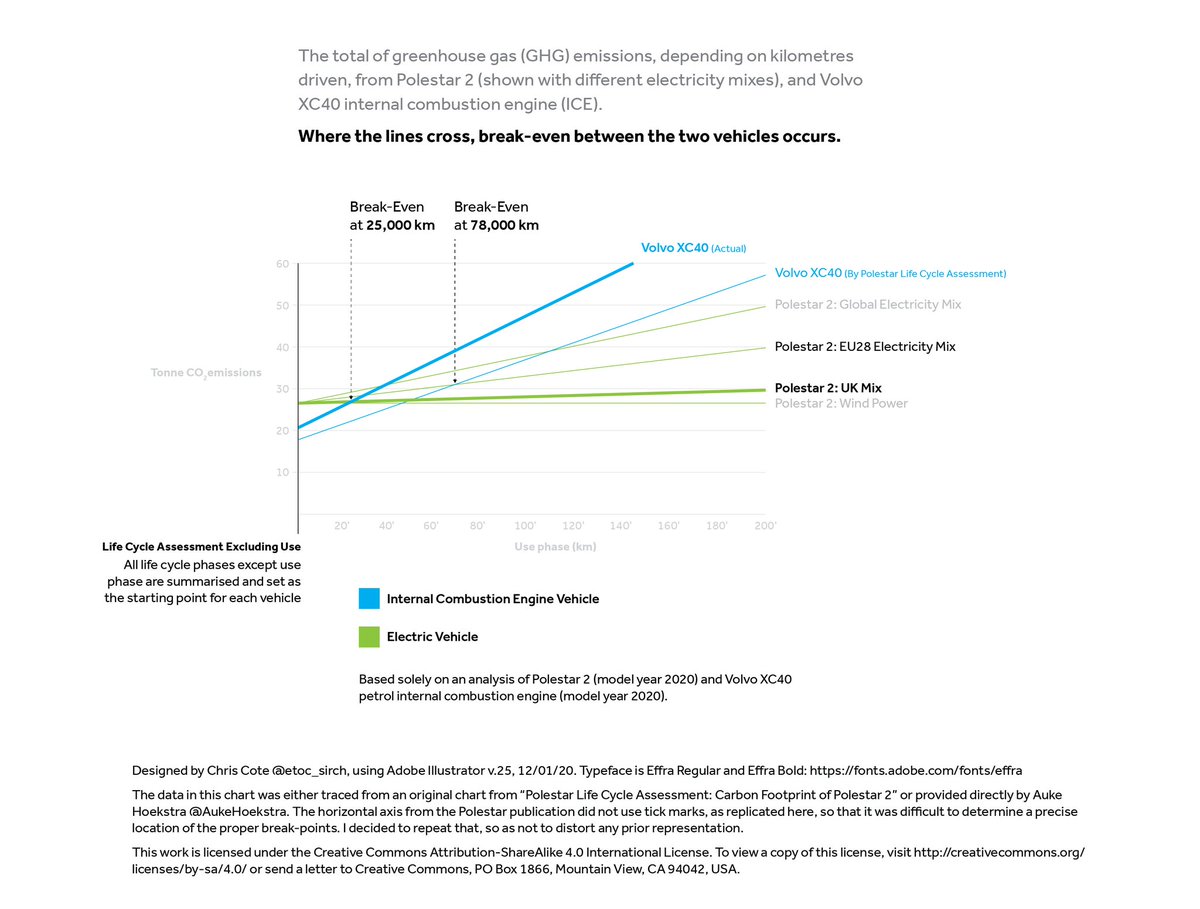
Youtube video reviewing the report I debunked and doing a very thorough (15 minute) job of pointing out everything that's going on. If only mainstream media outlets had the same level of expertise and accuracy...
• • •
Missing some Tweet in this thread? You can try to
force a refresh











